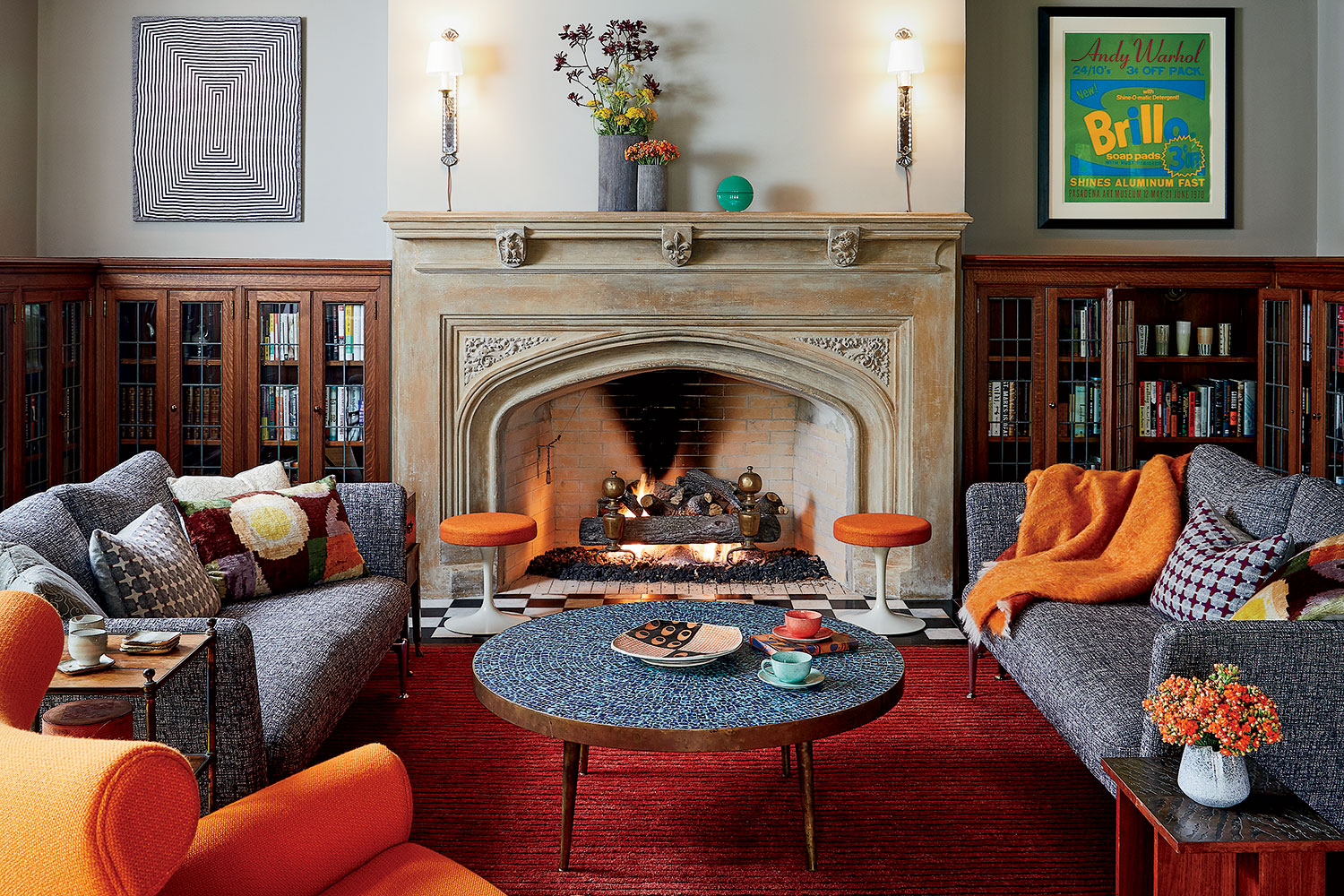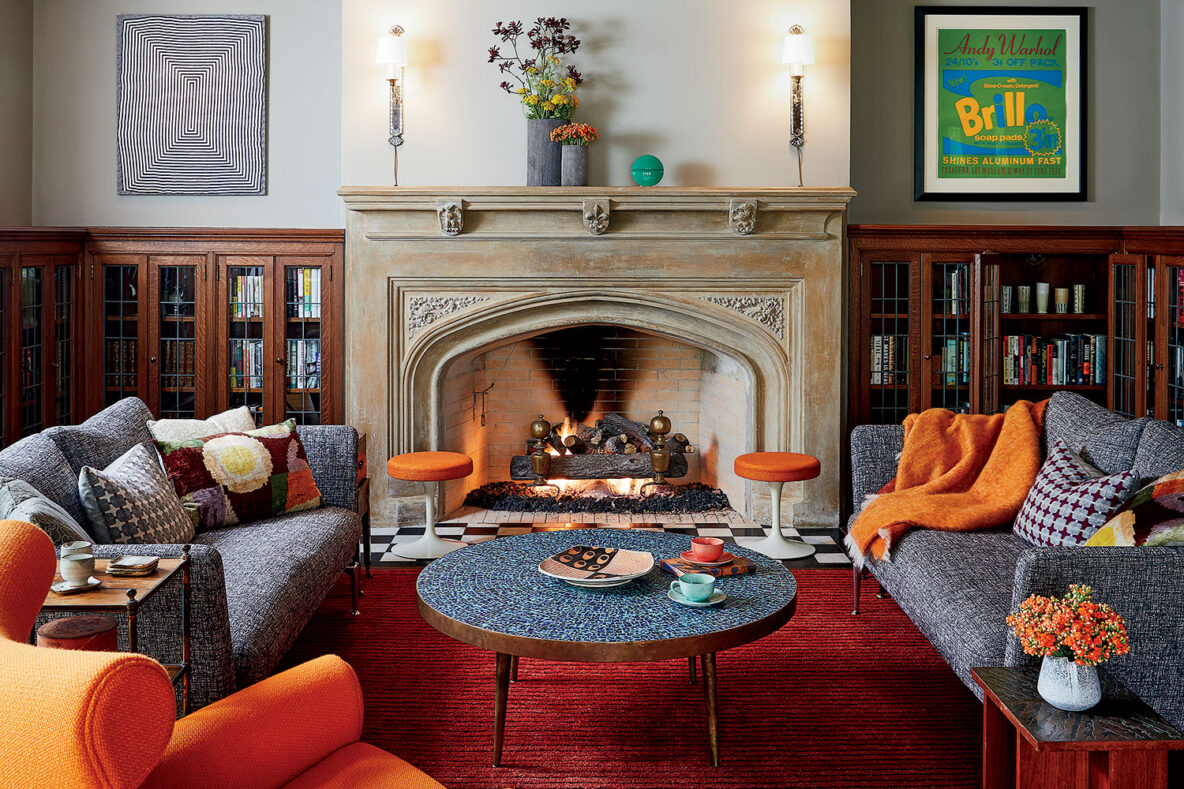How two devotees created a haven worthy of their stunning private stash
BY HEIDI MITCHELL

When you live in the kind of house that requires you to restore 90 leaded glass windows and replace a copper roof (twice) plus seven headless gargoyles, curious strangers tend to come knocking on the door. Such has been the experience at a Kenwood mansion owned by sculptor Melissa Weber and her husband, Jay Dandy, a research assistant at the Art Institute of Chicago. “One time a guy who worked for Reverend Clarence Cobbs, who lived here for 30 years, came by,” Weber recalls. “Another time, an expert with the Hyde Park–Kenwood Historic District wanted a tour.”
These days, it’s the art crowd that covets an invitation to one of the many art openings hosted by the passionate collectors, who have filled their 11,000-square-foot Gothic Revival with pieces that contrast with the dark and decorative architecture. Among their trove: 85 or so George Nelson clocks, several Andy Warhol silkscreens, a handful of Roy Lichtenstein prints, ceramics by Theaster Gates and Suze Lindsay, some rather sexy Tom Wesselmanns, and one taxidermied honey-colored black bear. “We didn’t want to make an expected house,” Dandy says.
The couple never anticipated living in such a storied home — at least, not one that diverges so dramatically from their typical taste for midcentury modern design. But once they had two sets of twins (now ages 19 and 22) and enrolled them in the University of Chicago Laboratory Schools in Hyde Park, moving from Wicker Park made sense. That was in 2002. “We’d go trick-or-treating to look at houses, and we must have formally toured at least a dozen,” recalls Dandy, noting that the family’s previous residence was a tall and narrow Victorian.
With its generous proportions, 11 bedrooms, coffered ceilings, and grand central staircase, the red-brick Kenwood house was irresistible. Charles Sumner Frost, who designed Navy Pier, built it in 1909 for the president of the Union Stock Yard & Transit Co., which was the impetus for Carl Sandburg’s famous description of Chicago as “Hog Butcher for the World.” (At the time, the company supplied around 80 percent of the nation’s meat.)
The couple could look past the vinyl wallpaper that covered nearly every surface, the water-damaged roof, the 490 crumbling cast-concrete window surrounds, and the leaks in every bathroom. In fact, they inhabited the aging pile for a decade before touching anything. “When you live in a space, you know how you use it,” says Weber. “There’s a benefit to waiting.” Even if that meant that 100 moving boxes sat in storage, a bearskin rug hibernated in a plastic bag, and the home’s quarter-sawn oak floors remained buried under ’70s plush white carpets. A relatively slack attitude toward upkeep settled in. As Weber recalls: “The kids spilled grape juice? Oh well! The dog kicked the wall? Oh well!”
Eventually, in 2012, the couple hired architect Paul Florian and Goldberg General Contracting to undertake a two-year renovation that would touch nearly every nook and cranny, down to the plumbing and wiring. “Jay was skeptical that it would work, but the final composition is amazing,” says Weber.
Now every exposed beam and coffered wall or ceiling has been stripped and refinished; each doorknob and hinge polished or replaced. Dandy’s beloved Nelson clocks run along the frieze of the foyer, with its church-like ornateness. That bearskin rug sits at last under a glossy Steinway, and each child has claimed one of the bedrooms.
As for the couple’s prized art collection? “We spent a year unpacking all the art we’d been keeping in storage,” Weber says. “It was like Christmas.” Out came the Samantha Bittman textiles, the gradient-painted stack of Styrofoam cups by Tom Friedman, the William Wegman photo, the Claes Oldenburg plaster wedding cake. A George Nelson bench and a daring red Odegard rug anchor the master bedroom, which attaches to a giant two-vanity bathroom — made by repurposing two bedrooms. “I keep my favorite objects in here,” Weber confides.
On the third floor, past a gallery wall, are the couple’s office and archives, where they spend much of their time. Florian created a steel bracket to expand the grand fireplace (one of the mansion’s three) to match an enormous sitting nook carved into the opposite wall. Being a researcher, Dandy has a spot for every book he’s collected, either on shelves or on draft tables set beneath Roman arches. As in the rest of the home, there’s no overt matchy-matchiness here.
Weber has a degree in interior design, but she describes this makeover as a “very personal renovation, not a designer’s vision.” Despite its museum-like appearance, the home is always filled with kids or guests. “It’s a place to celebrate life.”







